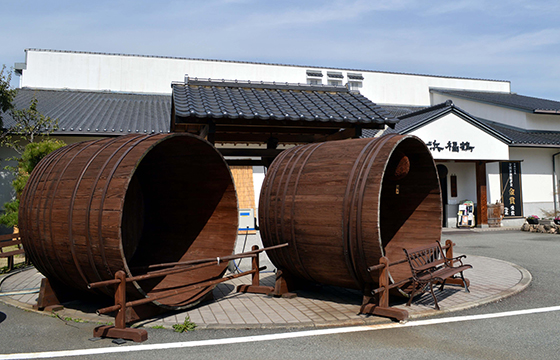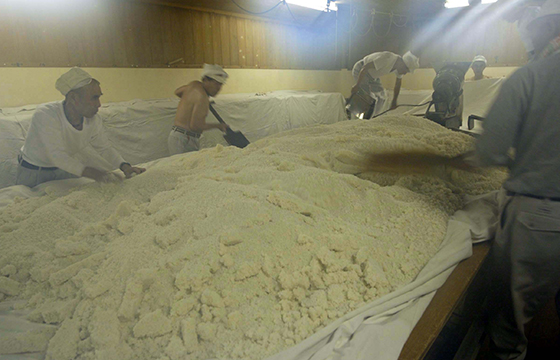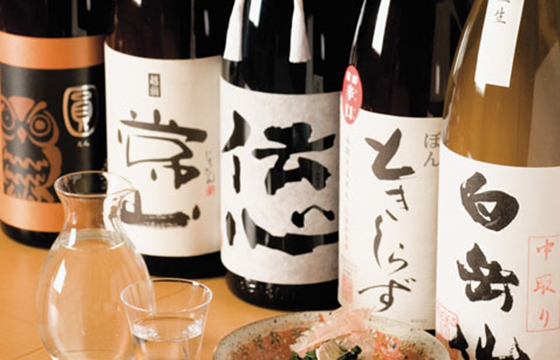
Sake

Nada and Fushimi areas account for 45% of total production Although there are many sake-producing areas in Japan, Nada (Hyogo prefecture) and Fushimi (Kyoto prefecture) represent Japan's finest breweries accounting for 45% of total production.
in Nada, the Water used for nihon-shu making is miya-mizu (from Rokko mountain range), and the rice is Yamda nishiki (from North Western Rokko) and to (the chief sake master) from Tanba.
In Fushimi, water from Fukuryusui (Fushimi hills) is perfect for sake making.
By the mid-Edo period, both areas had become known as sake makers of Japan Nada and Fushimi are referred to as the number one sake spots in Japan not only for their share in production but also by the atmosphere these breweries carry into the town.
One attract tion is that the sake brewery uses the most high tech brewing production lines and yet retains the old hand-made brewing methods.
In addition, each kuramoto (brewery) allows us to enjoy the traditional sake making process by appealing to both the eye and the ear with their efforts to get the message across Fushimi became a castle town in the late 16th century by Toyotomi Hideyoshi, and by the Edo period, water routes were organized and become a major gateway to Kyoto and Osaka.
Fushimi flourished as a port as well as a convenient stop over town for sankin-kotai samurais (samurai on duty visiting Edo on alternate years) thus the number of kuramoto increased and became renowned as a sake making town as we know it today.
Even now, one can find the row of Willow trees and dirt-built breweries along-side the Hori River, where we can find the hints of the old fashioned nihon-shu making process.
Nihon-shu from Nada was nationally renowned together with its famous Miya-mizu.
It has appealed to the palates of clear, sophisticated flavor, and the people in Edo have nicknamed it "a sake trickled down from the Kamigata (Kansai area which is centered around the cities of Kyoto and Osaka).
" The quality of sake greatly improved after the Meiji period With the evolution in sake brewing processes, but in 1995, the Great Hanshin-AWay Earthquake destroyed much of these breweries, "Nada Gogo" (the five sake producing areas in Nada district: Imazu-go, Nishinomiya go, Uozaki-go, Mikage-go, and Nishi-go) came together to put extra efforts into reconstruction of the area and since then has become one of the major tourist attractions of the Hanshin area.
As the saying goes, "whore there's good water, there's good sake," nihon-shu requires good quality water.
Needless to say, each area in Kansai-Hakusan Mountains in Fukui, Hakodate Mountains in Shiga, Katsuragi Mountains in Nara, Satsuki Mountain in Osaka, Chugoku Mountain ranges and Ibo River in Hyogo, Kinokawa in Wakayama, Suzuka Mountains, Nonobiki Mountains, Kii Mountains in Mie, and Yoshino River in Tokushima - has good water, and good nihon-shu is available as a results.
in Nada, the Water used for nihon-shu making is miya-mizu (from Rokko mountain range), and the rice is Yamda nishiki (from North Western Rokko) and to (the chief sake master) from Tanba.
In Fushimi, water from Fukuryusui (Fushimi hills) is perfect for sake making.
By the mid-Edo period, both areas had become known as sake makers of Japan Nada and Fushimi are referred to as the number one sake spots in Japan not only for their share in production but also by the atmosphere these breweries carry into the town.
One attract tion is that the sake brewery uses the most high tech brewing production lines and yet retains the old hand-made brewing methods.
In addition, each kuramoto (brewery) allows us to enjoy the traditional sake making process by appealing to both the eye and the ear with their efforts to get the message across Fushimi became a castle town in the late 16th century by Toyotomi Hideyoshi, and by the Edo period, water routes were organized and become a major gateway to Kyoto and Osaka.
Fushimi flourished as a port as well as a convenient stop over town for sankin-kotai samurais (samurai on duty visiting Edo on alternate years) thus the number of kuramoto increased and became renowned as a sake making town as we know it today.
Even now, one can find the row of Willow trees and dirt-built breweries along-side the Hori River, where we can find the hints of the old fashioned nihon-shu making process.
Nihon-shu from Nada was nationally renowned together with its famous Miya-mizu.
It has appealed to the palates of clear, sophisticated flavor, and the people in Edo have nicknamed it "a sake trickled down from the Kamigata (Kansai area which is centered around the cities of Kyoto and Osaka).
" The quality of sake greatly improved after the Meiji period With the evolution in sake brewing processes, but in 1995, the Great Hanshin-AWay Earthquake destroyed much of these breweries, "Nada Gogo" (the five sake producing areas in Nada district: Imazu-go, Nishinomiya go, Uozaki-go, Mikage-go, and Nishi-go) came together to put extra efforts into reconstruction of the area and since then has become one of the major tourist attractions of the Hanshin area.
As the saying goes, "whore there's good water, there's good sake," nihon-shu requires good quality water.
Needless to say, each area in Kansai-Hakusan Mountains in Fukui, Hakodate Mountains in Shiga, Katsuragi Mountains in Nara, Satsuki Mountain in Osaka, Chugoku Mountain ranges and Ibo River in Hyogo, Kinokawa in Wakayama, Suzuka Mountains, Nonobiki Mountains, Kii Mountains in Mie, and Yoshino River in Tokushima - has good water, and good nihon-shu is available as a results.
TM © Rugby World Cup Limited 2015. All rights reserved.
)
)
)
)